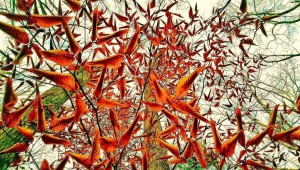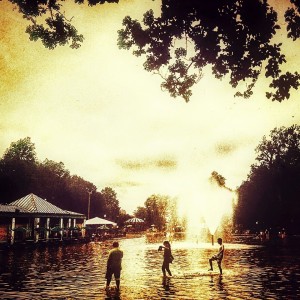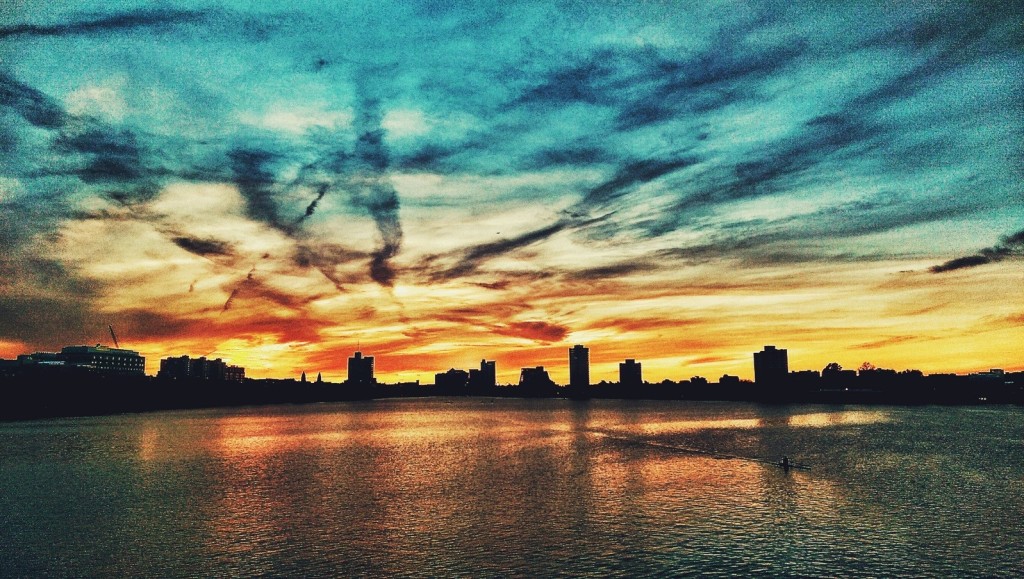by Gavriel Elkind
“Instructions for living a life:
Pay attention.
Be astonished.
Tell me about it.”–Mary Oliver, from “Sometimes”
The sun is setting over the Charles River. I am walking home from work and humming along to “Taking It In” by James Taylor. I’m still several blocks away from the Harvard Bridge when I catch glimpses of the sky through the narrow cracks between the brownstones. I can tell from the angle of the light that I’m missing the sunset so I break into a run, the heels of my boots pounding against the pavement.
The view that greets me from the bridge simultaneously takes my breath away and restores it. The sky is a watercolor exercise in contrast: fiery oranges streak the bottom of the horizon, while icy blues glide across the top. Wispy tendrils of purple and gray linger in the liminal spaces between. The river in the foreground is placid, reflecting and magnifying the brilliance of the colors, its stillness interrupted by a lone soul rowing away from the horizon. The city is electric. I pull my cell phone out and aim the camera at the view.
 I took up photography a little over a year ago. At the time, I was living in San Francisco, a magnificent city pulsing with beauty and life. But I had slipped into a grinding routine that left me hurrying mindlessly through my days. Each morning, I walked quickly to work along the road that borders the San Francisco Bay, eager to avoid the ever-present droves of tourists. One day, I noticed a crowd gathering on a pier. I followed their gaze to the Bay Bridge—and I was stunned. The sun pried open the clouds and spilled amber light onto a narrow swath of the Bay. I hurriedly took a photo with my phone. And as I watched from behind my tiny screen, the moment passed. The fog rolled in. All that had shimmered only seconds before now seemed gray and lifeless.
I took up photography a little over a year ago. At the time, I was living in San Francisco, a magnificent city pulsing with beauty and life. But I had slipped into a grinding routine that left me hurrying mindlessly through my days. Each morning, I walked quickly to work along the road that borders the San Francisco Bay, eager to avoid the ever-present droves of tourists. One day, I noticed a crowd gathering on a pier. I followed their gaze to the Bay Bridge—and I was stunned. The sun pried open the clouds and spilled amber light onto a narrow swath of the Bay. I hurriedly took a photo with my phone. And as I watched from behind my tiny screen, the moment passed. The fog rolled in. All that had shimmered only seconds before now seemed gray and lifeless.
I was late for work that morning. I kept returning to my photos in disbelief, doubting if that glorious moment had actually transpired. It was so brief—and I nearly missed it. But the images on my screen proved its realness. As I stared at the sun pushing through the fog, I wondered: how often does the world speak—loudly, clearly, and directly—and we are too preoccupied to hear it? How frequently do we miss the precise moment when the light breaks through the dark because we simply aren’t looking?
Before that day, I struggled to cultivate a practice of mindfulness. I tried different styles of meditation, but I had difficulty maintaining a daily ritual. My experience on the pier revealed a truth I had suspected for some time: I wasn’t paying attention to the details of my life. And mindfulness is, at its most basic, about paying attention. Jon Kabat-Zinn explains that it is “about living your life as if it really mattered, moment by moment by moment by moment.” But how can we know what truly matters about each moment if we are rushing mindlessly through life with our heads down? How can we make meaning and find inspiration? How can we determine what is unmissable about a moment—and how can we purposefully make each one matter?
 Taking photographs enhances my sense of mindfulness because it teaches me how to pay attention. I’m not yet sophisticated with the craft; I still use the camera on my phone. But my cell phone—portable, accessible, (almost always) present—is, contrary to what one might expect, a critical asset in this process of more mindful living. With a camera perpetually within arm’s reach, everything is worthy of my gaze, imagination, and examination. I deviate from my running route to document the tiny flowers blooming in the cracks in the sidewalk. I take pictures of the trees that line my street in Boston and watch the seasons at work on their leaves and bark. I return to the same sun-speckled alley near my office time and again hoping to finally do justice to a photo I’ve been imagining for months. Photography inspires me to marvel at these details and grapple with the enormous concepts they encapsulate: awe, energy, vulnerability, interaction, connection, loneliness, mystery, time, beauty, and coexistence. After years of walking with my eyes on the ground, photography has reawakened me, and brought my eyes back up to the world.
Taking photographs enhances my sense of mindfulness because it teaches me how to pay attention. I’m not yet sophisticated with the craft; I still use the camera on my phone. But my cell phone—portable, accessible, (almost always) present—is, contrary to what one might expect, a critical asset in this process of more mindful living. With a camera perpetually within arm’s reach, everything is worthy of my gaze, imagination, and examination. I deviate from my running route to document the tiny flowers blooming in the cracks in the sidewalk. I take pictures of the trees that line my street in Boston and watch the seasons at work on their leaves and bark. I return to the same sun-speckled alley near my office time and again hoping to finally do justice to a photo I’ve been imagining for months. Photography inspires me to marvel at these details and grapple with the enormous concepts they encapsulate: awe, energy, vulnerability, interaction, connection, loneliness, mystery, time, beauty, and coexistence. After years of walking with my eyes on the ground, photography has reawakened me, and brought my eyes back up to the world.
As eagerly as it can encourage us to live more attentively, photography—especially in the modern digital age—also has the potential to get in the way of mindfulness by removing us from the present. If we are fooled into believing that a photograph stops time or serves as proof of our presence, we may miss the chance to experience the moment in all its richness. I am always tempted, for instance, to document the first time I meet my friends’ children. But I can’t comprehend how brightly the room glows when they smile if I am trying to capture an Instagram-worthy shot. Similarly, I often feel compelled to take pictures during social situations, and the pressure to preserve only the good means that I tend to gloss over the ugly. Photography can enhance our sense of mindfulness by drawing our attention to precious intricacies that we might have otherwise missed—but it can also rob us of our capacity to experience the presence in all its messy and wondrous glory.
In a 2015 commencement address, poet and activist Parker Palmer advised graduates: “If the unexamined life is not worth living, it’s equally true that the unlived life is not worth examining.” Photography helps me identify the middle ground where mindful examination and exuberant existence thrive in tandem. Striving for this balance means that I must cultivate my ability to carve into the deep, soft marrow of a moment and extract its essence. It requires that I lift up my head when I walk the same path, day after day, so that I don’t miss the light breaking through the fog. It begs that I notice the subtle shift in the color of the leaves as we bend towards spring. It requests that I run through the streets of Boston in my high heels, kneel in the fresh snow, and wander through the woods searching for the images I’ve envisioned—and those beyond the boundaries of my imagination. This pursuit of synchrony between examination and existence encourages me to reach for my camera in moments that are difficult to translate—and leave it aside when I feel tempted to suspend or edit time. It urges me to trust that my own memories of an unforgettable moment are often more meaningful than any photographs I can take. It asks that I be astonished.
 That evening on the Harvard Bridge, I took several photos of the sunset. And then I put my phone away and stood still until the light faded from the sky. When I think about that night, I not only recall the way the colors bled together and the city glowed. I remember singing along with James Taylor: “You know you can’t buy tomorrow, no, it’s all a matter of opening up your eyes/and looking around ‘cause it’s all there, it’s all there, I said, taking the sunshine in.” I remember the wind stroking my cheeks. And I remember wondering what that woman thought as she rowed through the illuminated water. Maybe she was marvelling at how achingly beautiful and intricate it can be, the well-lived and well-examined life. Or perhaps she wasn’t thinking at all as the night closed in around her. Perhaps she was listening to the shallow waves gently lapping against her boat, and feeling the weight of the wooden oar in her hand, and watching the tiny silhouettes of passers-by on the Harvard Bridge above her. Perhaps that was why this moment mattered after all.
That evening on the Harvard Bridge, I took several photos of the sunset. And then I put my phone away and stood still until the light faded from the sky. When I think about that night, I not only recall the way the colors bled together and the city glowed. I remember singing along with James Taylor: “You know you can’t buy tomorrow, no, it’s all a matter of opening up your eyes/and looking around ‘cause it’s all there, it’s all there, I said, taking the sunshine in.” I remember the wind stroking my cheeks. And I remember wondering what that woman thought as she rowed through the illuminated water. Maybe she was marvelling at how achingly beautiful and intricate it can be, the well-lived and well-examined life. Or perhaps she wasn’t thinking at all as the night closed in around her. Perhaps she was listening to the shallow waves gently lapping against her boat, and feeling the weight of the wooden oar in her hand, and watching the tiny silhouettes of passers-by on the Harvard Bridge above her. Perhaps that was why this moment mattered after all.
Check out Gavriel’s photos at: https://haystackoflight.wordpress.com/
Twitter and Instagram: @gavrielski
Latest posts by Admin (see all)
- The Necessity of Mindfulness: Seeing Things as They Really Are - October 6, 2021
- How Mindfulness Saved My Life - August 8, 2021
- Mindfulness: A Bird’s-Eye View - July 11, 2021

Thank you. Your words and photos are a meditation in themselves.
Thank you so much for your kind words, Kathryn.